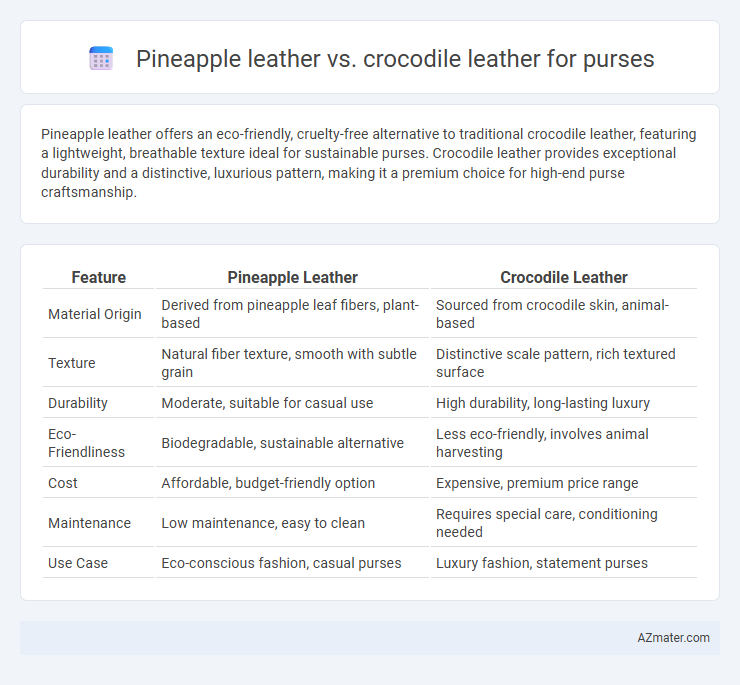Pineapple leather offers an eco-friendly, cruelty-free alternative to traditional crocodile leather, featuring a lightweight, breathable texture ideal for sustainable purses. Crocodile leather provides exceptional durability and a distinctive, luxurious pattern, making it a premium choice for high-end purse craftsmanship.
Table of Comparison
| Feature | Pineapple Leather | Crocodile Leather |
|---|---|---|
| Material Origin | Derived from pineapple leaf fibers, plant-based | Sourced from crocodile skin, animal-based |
| Texture | Natural fiber texture, smooth with subtle grain | Distinctive scale pattern, rich textured surface |
| Durability | Moderate, suitable for casual use | High durability, long-lasting luxury |
| Eco-Friendliness | Biodegradable, sustainable alternative | Less eco-friendly, involves animal harvesting |
| Cost | Affordable, budget-friendly option | Expensive, premium price range |
| Maintenance | Low maintenance, easy to clean | Requires special care, conditioning needed |
| Use Case | Eco-conscious fashion, casual purses | Luxury fashion, statement purses |
Introduction to Pineapple Leather and Crocodile Leather
Pineapple leather, also known as Pinatex, is an innovative, sustainable material made from pineapple leaf fibers that offers an eco-friendly alternative to traditional animal leathers. Crocodile leather, prized for its distinctive scale pattern and durability, remains a luxury material known for its high cost and exclusivity. Both materials cater to different consumer preferences, with pineapple leather appealing to environmentally conscious buyers and crocodile leather attracting those seeking premium aesthetics and longevity.
Material Origins: How Each Leather is Made
Pineapple leather, known as Pinatex, is derived from the fibers of pineapple leaves, a sustainable byproduct of the agricultural industry, processed into a non-woven textile that mimics traditional leather's durability and texture. Crocodile leather, sourced from the skins of farmed or wild crocodiles, undergoes a tanning process to preserve the distinctive scale pattern, resulting in a luxurious and high-end material prized in fashion. The environmental impact of pineapple leather is considerably lower due to its plant-based origin and waste utilization, whereas crocodile leather requires intensive animal farming and resource-heavy processing.
Sustainability and Environmental Impact
Pineapple leather, made from sustainable Pinatex fibers derived from pineapple leaves, offers an eco-friendly alternative to traditional crocodile leather, significantly reducing deforestation and habitat destruction. Crocodile leather involves intensive water use, chemical tanning, and often contributes to biodiversity loss through illegal poaching practices. Choosing pineapple leather supports cruelty-free production, lowers carbon footprint, and promotes circular fashion by utilizing agricultural waste.
Durability and Longevity Comparison
Pineapple leather, a sustainable alternative made from pineapple leaf fibers, offers moderate durability with natural resistance to wear but may show signs of aging faster than crocodile leather. Crocodile leather is renowned for its exceptional toughness, water resistance, and longevity, often lasting decades with proper care, making it a premium choice for purses. While pineapple leather is eco-friendly and lightweight, crocodile leather outperforms in long-term durability and maintains its luxurious appearance over time.
Aesthetic Differences: Texture and Appearance
Pineapple leather showcases a distinctive textured surface resembling the natural pattern of pineapple fibers, offering a matte finish with subtle, organic irregularities that enhance its eco-friendly appeal. Crocodile leather boasts a glossy, highly durable surface characterized by pronounced, symmetrical scales and a luxurious, polished sheen that signifies exclusivity and sophistication. The contrast in texture and appearance between pineapple leather's natural, fibrous look and crocodile leather's structured, opulent pattern defines their unique aesthetic identities in purse design.
Ethical Considerations: Vegan vs Exotic Leather
Pineapple leather, an innovative vegan alternative made from sustainable pineapple leaf fibers, offers cruelty-free and environmentally friendly benefits compared to crocodile leather, which involves animal exploitation and habitat disruption. Ethical considerations favor pineapple leather as it reduces the carbon footprint and aligns with cruelty-free fashion standards, appealing to consumers seeking sustainable luxury. Crocodile leather purses, while durable and prestigious, raise significant animal welfare concerns and contribute to the demand for exotic skins, fostering illegal poaching and biodiversity loss.
Maintenance and Care Requirements
Pineapple leather requires minimal maintenance, needing only occasional wiping with a damp cloth and avoiding prolonged exposure to direct sunlight or moisture to prevent damage. Crocodile leather demands more intensive care, including regular conditioning with specialized leather oils to maintain suppleness and prevent cracking, as well as careful storage to avoid deformation. Both materials benefit from avoiding harsh chemicals and excessive water, but crocodile leather's natural oils and textured surface make it more sensitive to environmental factors.
Price Comparison: Cost of Each Leather Type
Pineapple leather typically costs significantly less than crocodile leather, with prices ranging from $50 to $150 per square foot compared to crocodile leather's $500 to $1,200 per square foot. Crocodile leather's high price is driven by its rarity, durability, and luxury status, making it a premium choice for purses. Pineapple leather, as a sustainable eco-friendly alternative, offers a budget-friendly option without compromising on aesthetic appeal or durability.
Fashion Industry Trends and Consumer Preferences
Pineapple leather, derived from sustainable Pinatex fibers, has gained traction in the fashion industry due to its eco-friendly credentials and trendy texture, appealing to environmentally conscious consumers. Crocodile leather remains a symbol of luxury and exclusivity, favored for its distinctive pattern and durability, often driving high-end market demand despite ethical concerns. Consumer preferences are shifting towards innovative materials like pineapple leather as the demand for cruelty-free and sustainable alternatives grows alongside traditional exotic leathers.
Final Verdict: Choosing the Right Leather for Your Purse
Pineapple leather offers a sustainable and cruelty-free alternative with a lightweight, flexible texture ideal for eco-conscious consumers, while crocodile leather provides unmatched durability and a luxurious, timeless aesthetic favored in high-end fashion. Consider your priorities: pineapple leather excels in ethical appeal and modern innovation, whereas crocodile leather commands prestige and longevity but requires careful maintenance. Selecting the right leather depends on balancing environmental impact, style preference, and the purse's intended use.

Infographic: Pineapple leather vs Crocodile leather for Purse
 azmater.com
azmater.com